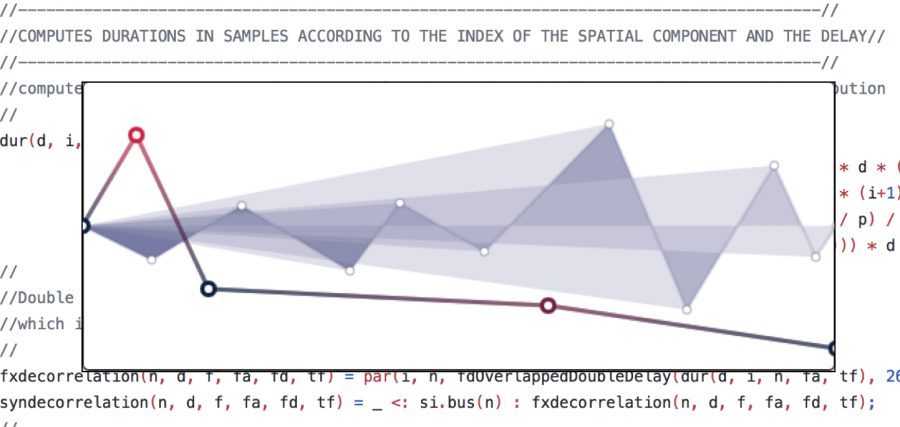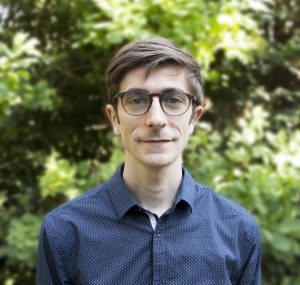

Paul Goutmann, Modular representations and notation of spatial sound processing: an approach to music and software creation
PROJECT DURATION
2020 - 2023
PROJECT OWNER(S)
Paul Goutmann
The spatial dimension of sound is essential in the field of contemporary music creation, especially in electroacoustic and electronic music. Today, concert halls and studios are equipped with multipoint diffusion systems. The sound spatialisation tools shared by the scientific and musical communities are dominated by a Euclidean thought of space, with the source reduced to a point as the fundamental object. This approach can be found in the repertoire, for example, in Pierre Boulez’s work Répons. In contrast, Luigi Nono’s Prometeo seeks to explore the plurality of voices, the profusion, and the indeterminacy of positions: the diffuse sound field.
Since the 1990s, several software implementations of sound spatialisation algorithms have made spatialisation operations accessible. These operations mainly involve trajectory editing and room acoustic simulation. Many works have developed alternative approaches to spatial audio, such as processing by granulation or microtemporal decorrelation, which inherit the approaches of composers Iannis Xenakis and Horacio Vaggione. The HOAlibrary developed at CICM as part of the Arts-H2H LabEx projects has made it possible to explore the musical potential of these approaches in the Ambisonics model. However, these techniques are not widely adopted beyond a small community of composer-researchers and experimental artists. The lack of an operative representation for spatial audio processing makes it difficult to access musical creation with these tools.
In this context, we conduct research on interfaces for spatial audio processing using a research-creation methodology that combines software development and musical composition. Through an experimental framework founded on an iterative loop that involves the creation of graphical interface prototypes, spatial audio processing, and personal electroacoustic compositions, we examine the notions of interface and interaction. Our study then focuses on the complex articulation between the different layers of the digital audio composition framework. We explore how the development of interfaces for spatial audio processing influences the creation of sound spaces, and vice versa, how composition impacts the design of interfaces with sound spatiality.
Biography

Paul Goutmann is a French musician, composer, and researcher. He holds a Master’s degree in Musicology specialised in “Composition and Realisation” and a Music Studies diploma of the CRR93 in Creation. Currently, he is a contractual PhD candidate at EUR ArTeC, preparing a thesis co-directed by Alain Bonardi and Anne Sedes within the Center for Research in Computer and Music Creation (CICM, Musidanse, EDESTA). His research focuses on interfaces for spatial audio processing. Active in the artistic field, his reflections on sound spatialisation are reflected in his practice of computer music design, sound recording, and creation for the theatre. He has collaborated with several directors (L. Favret, S. Mirzai, A. Acerbis, V. Thimonier) and was a recipient of the Creation en Cours program from Ateliers Médicis. As part of the ” Habiter (avec) Xenakis” project, he proposed a spatialisation of the piece “Voyage Absolu des Unari vers Andromède” by I. Xenakis for the Cité des Sciences planetarium (Philharmonie de Paris event) and for the Xenakis Alive concert (Onassis Stegi National Conservatory of Athens) in 2022. Since 2023, he has been collaborating as an artist-researcher with the theatre company Les Temps Blancs for the Anachronique Paléolithique research-creation project as part of the QUID electronic duo.
- Publications
In proceedingss
Paul Goutmann, Alain Bonardi. « Approaching Spatial Audio Processing by Means of Decorrelation and Ring Modulation in Ambisonics » Sound and Music Computing, Université Jean Monnet, Saint-Étienne; GRAME; INRIA, Jun 2022, Saint-Étienne, France.
Paul Goutmann, Alain Bonardi. « From stereophonic to spatial audio processing: Voyage absolu des Unari vers Andromède by Iannis Xenakis. Centenary International Symposium XENAKIS 22: Lectures Workshops Concerts, Anastasia Georgaki, National and Kapodistrian University of Athens, Makis Solomos, Université Paris 8, 2022, Athens, Greece.
Paul Goutmann, « Traitement spatial du son par décorrélation des signaux en ambisonie d’ordre élevé ». Journées d’Informatique Musicale 2021, AFIM, Jul 2021, Visioconférence, France. [Prix du Jeune Chercheur de l’AFIM]
- Software
Contribution to the Faust version of the HOA library developed by P. Guillot, E. Paris, and J. Colafrancesco: addition of decorrelation and ambisonic 2D/3D ring modulation processing and modification of the 2D decoder (since 2022).
Contribution to the Faust abc.lib library developed by Alain Bonardi: addition of distribution functions, graphical user interface for ambisonic processing, 2D decoders, and their Max and PureData help patches (since 2021).
PROJECT TEAM
“Représentations modulaires et notation du traitement spatial du son : une approche de la création musicale et logicielle” est dirigé par Alain Bonardi et co-dirigé par Anne Sedès au sein de l’équipe du Centre de recherche en Informatique et Création Musicale du laboratoire Musidanse (EA1572).











